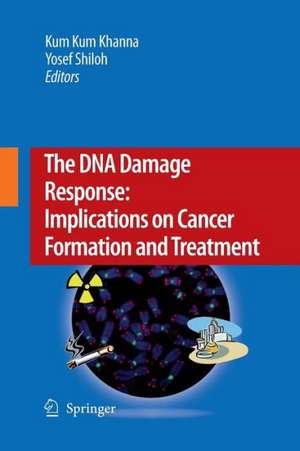The DNA Damage Response: Implications on Cancer Formation and Treatment
Editat de Kum Kum Khanna, Yosef Shilohen Limba Engleză Paperback – 12 noi 2014
| Toate formatele și edițiile | Preț | Express |
|---|---|---|
| Paperback (1) | 1103.39 lei 43-57 zile | |
| SPRINGER NETHERLANDS – 12 noi 2014 | 1103.39 lei 43-57 zile | |
| Hardback (1) | 1109.44 lei 43-57 zile | |
| SPRINGER NETHERLANDS – 18 noi 2009 | 1109.44 lei 43-57 zile |
Preț: 1103.39 lei
Preț vechi: 1161.47 lei
-5% Nou
Puncte Express: 1655
Preț estimativ în valută:
211.13€ • 221.03$ • 174.70£
211.13€ • 221.03$ • 174.70£
Carte tipărită la comandă
Livrare economică 07-21 aprilie
Preluare comenzi: 021 569.72.76
Specificații
ISBN-13: 9789400779952
ISBN-10: 940077995X
Pagini: 464
Ilustrații: XII, 449 p.
Dimensiuni: 155 x 235 x 24 mm
Greutate: 0.64 kg
Ediția:2009
Editura: SPRINGER NETHERLANDS
Colecția Springer
Locul publicării:Dordrecht, Netherlands
ISBN-10: 940077995X
Pagini: 464
Ilustrații: XII, 449 p.
Dimensiuni: 155 x 235 x 24 mm
Greutate: 0.64 kg
Ediția:2009
Editura: SPRINGER NETHERLANDS
Colecția Springer
Locul publicării:Dordrecht, Netherlands
Public țintă
ResearchCuprins
DNA Damage Sensing and Signaling.- Signaling at Stalled Replication Forks.- An Oncogene-Induced DNA Replication Stress Model for Cancer Development.- Cellular Responses to Oxidative Stress.- Cell Cycle Regulation and DNA Damage.- Chromatin Modifications Involved in the DNA Damage Response to Double Strand Breaks.- Telomere Metabolism and DNA Damage Response.- DNA Double Strand Break Repair: Mechanisms and Therapeutic Potential.- DNA Base Excision Repair: A Recipe for Survival.- DNA Damage Tolerance and Translesion Synthesis.- Nucleotide Excision Repair: from DNA Damage Processing to Human Disease.- Chromosomal Single-Strand Break Repair.- Mouse Models of DNA Double Strand Break Repair Deficiency and Cancer.- Cancer Biomarkers Associated with Damage Response Genes.- Linking Human RecQ Helicases to DNA Damage Response and Aging.- Single-Stranded DNA Binding Proteins Involved in Genome Maintenance.- The Fanconi anemia-BRCA Pathway and Cancer.- BRCA1 and BRCA2: Role in the DNA Damage Response, Cancer Formation and Treatment.
Textul de pe ultima copertă
The book The DNA Damage Response: Implications on Cancer Formation and Treatment brings together a great collection of review articles. The articles have been written by a group of experts who have a deep knowledge of the recent advances in the fields of DNA damage signalling and repair and their implications in carcinogenesis.
The book is divided into chapters that deal with the elaborate surveillance system and repair mechanisms used by cells to suppress mutagenic lesions to avoid cancer. It provides snapshots of:
* current understanding of DNA damage signalling,
* cell cycle checkpoints,
* some of the major DNA repair pathways,
* functional links between DNA damage,
* genomic instability and cancer,
* implications of DNA damage for the development of new treatment modalities for cancer.
The book is divided into chapters that deal with the elaborate surveillance system and repair mechanisms used by cells to suppress mutagenic lesions to avoid cancer. It provides snapshots of:
* current understanding of DNA damage signalling,
* cell cycle checkpoints,
* some of the major DNA repair pathways,
* functional links between DNA damage,
* genomic instability and cancer,
* implications of DNA damage for the development of new treatment modalities for cancer.
Caracteristici
Offers up-to-date and comprehensive review of latest advances in DNA damage sensing, signalling and repair field Describes current bottlenecks and future directions Discusses the relationship between DNA damage repair and cancer Written by active investigators who have made important contributions in their respective areas











